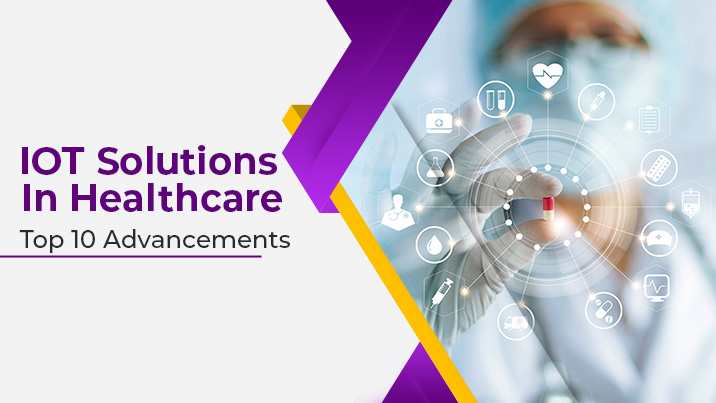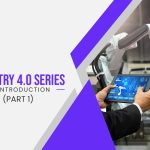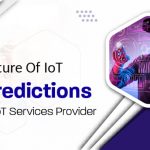What is IoT?
IoT is the Internet of Things, the interconnectivity of everything. It brings together and connects everything via the Internet, with the goal of improving our quality of life.
IoT can be understood as a technology that collects and analyses information from the physical world to help manage and solve problems. IOT solutions encompasses a number of different technologies, such as sensors, mobile devices, and social media. It can facilitate real-time decisions or provide historical data for future decisions.
IoT Solutions in Healthcare can be described as the use of information technology and communications (ITC) in healthcare activities, such as monitoring patients, predicting, and providing treatment and care.
How IoT Revolutionized Healthcare?

IOT is at the center of all future technology. It offers the possibility to develop IoT solutions that are embedded in everyday life and everyday objects. IoT solutions can be used to monitor and manage chronic diseases, like diabetes or COPD. It helps physicians monitor patients’ medication intake and allows healthcare professionals to create a comprehensive record of the patient’s lifestyle.
IoT Applications In Healthcare

IoT devices open up new avenues for healthcare practitioners to monitor patients, as well as for patients to monitor themselves. As a result, the variety of wearable IoT devices provides a plethora of benefits and issues for both healthcare providers and their patients. Here are some ways that IoT Solutions is transforming healthcare. We will also briefly discuss how using IoT devices for medical purposes affects data security.
1. Remote Patient Monitoring
This simple IoT solution uses remote patient monitoring technologies to allow providers to remotely monitor patient data, such as vitals, lab results, and other measurements. For example, a caregiver may be able to monitor the vitals of their patient via SMS, and it may then be read and used by a doctor in real time.
Patients can now take complete control of their own health outside of the medical setting with the use of IoT technologies. Remote patient monitoring can allow for patients to monitor their own health at home, in their cars, or in their offices. Patients are able to access this information through their Smartphones and other connected devices.
2. Glucose Monitoring
The diabetes community is heavily embracing the use of IoT solutions in their diabetes self-management. It allows patients to manage their diabetes without having to visit their doctors. A diabetic may need to monitor their blood glucose levels daily. This level of routine checking can be very helpful as a diabetes patient can take proactive steps to prevent complications stemming from hyperglycaemia and hypoglycaemia.
With the advent of new technologies, such as the use of IoT solutions, diabetes has become a manageable disease. With the aid of devices, such as the Smartphone, Smartwatch, and the glucose monitor, people can more easily monitor their blood sugar levels and adjust their diet accordingly.
3. Heart-Rate Monitoring
Heart rate monitoring is a great example of the role of new technologies in patient engagement. Using a wrist-worn monitor, patients can track their heart rate throughout the day and understand how this affects their overall health. For example, an avid runner may wish to monitor their heart rate and their pulse rate to know how well their body is responding to the stress of running or if they are experiencing an overtraining syndrome. Patients can also track changes in heart rate while they sleep.
No need to be attached to a wired device all the time. IoT solutions offer small handheld devices with wireless capabilities, allowing patients to monitor their heart rate while away from their doctor’s office. The device can be used anywhere anytime to determine the patient’s heart rate and then send the results to a doctor.
4. Hand Hygiene Monitoring
There are different IoT solutions that can be used to monitor hand hygiene. For example, some sensors and devices measure the time it takes for a thorough hand wash or the amount of hand sanitizer that is used. These solutions can provide the hospital and medical center staff with reminders and guides for optimal hand hygiene. This is vital for medical staffs before they get into surgery or attend to a patient.
5. Depression And Mood Monitoring
This is a major need in the current world setting. Many people have trouble managing their moods, especially when under stress. The use of IoT solutions can provide a way to identify and track these moods and provide a way for those managing their moods to track their progress.
Patients with depression can monitor their mood and medication use. This can help patients and their families, as well as their doctors, make better decisions about managing and treating depression. With the help of IoT technologies, patients can better control and understand their own mood. Mood tracking with IoT is a simple and effective way to determine a person’s depression or mood. A simple device can be worn throughout the day and send data to a caregiver or physician for diagnosis and improvement of mood. The patient can be a part of the diagnostic process, providing feedback about their depression level or mood.
6. Parkinson’s Disease Monitoring
Parkinson’s disease is a chronic neurodegenerative disease that causes tremors and shaking, difficulty in walking, and slow movements. For patients with Parkinson’s disease, IoT can help track medication use for the disease, record symptoms, and provide the caregiver with relevant data to treat the disease. At the same time, the gadgets allow patients to continue their lives in their own homes rather of being confined to a hospital for extended periods of time for surveillance.
It may be a challenge for a patient with Parkinson’s disease to remember to take their medication, particularly in the early stages of the disease. IoT solutions help patients by reminding them that it is time to take their medication. IoT solutions are a great way to monitor medication use and create a better understanding of the disease progression.
7. Connected Inhalers
Inhalers help patients manage asthma and other lung diseases. The inhaler can be connected to the Internet to allow the patient to monitor their medication dosage and to track their asthma condition.
IoT solutions can monitor when, and how, a patient uses an inhaler to understand the effectiveness of the treatment. Furthermore, connected inhalers can notify patients when they leave their inhalers at home, putting them at risk of having an attack without their inhaler, or when they use the inhaler incorrectly.
8. Ingestible Sensors
With ingestible sensors, it’s possible to collect information from digestive and other systems in a much less invasive way. These kinds of IoT solutions can potentially be used to monitor the health of patients such as diabetics or those with stomach ulcers.
For example, ingestible sensors allow doctors and researchers to collect data on a person’s digestive system and track how the person’s body processes medicines and food. These sensors may be used to track the progression of disease, monitor the effectiveness of a medication, or inform treatment decisions for patients.
9. Connected Contact Lenses
Smart contact lenses offer yet another IoT solution that has the potential for passive, non-intrusive healthcare data collection. In addition, they could feature micro-cameras that allow patients to snap images with their eyes, which is likely why Big Tech Companies have patented connected contact lenses.
Smart lenses, whether employed to improve health outcomes or for other purposes, have the potential to transform human eyes into a powerful tool for digital interactions.
10. Robotic Surgery
Robotic surgery is one of the key advancements in IoT solutions for healthcare. Surgeons can now execute sophisticated surgeries that would be impossible to manage with human hands by implanting miniature Internet-connected robots within the human body.
Robotic surgery is a revolutionary advancement in minimally invasive surgery which involves using robotic instruments that are able to operate directly inside body tissue. Robotic surgery has the potential to reduce the trauma of routine surgeries, while allowing surgeons to perform more complex procedures.
These gadgets must be tiny and dependable enough to allow for minimal disruption during surgery. They must also be able to comprehend complex circumstances inside the body in order to make the best decisions during a surgery. However, IoT robots are currently being utilized in surgery, demonstrating that these issues can be appropriately addressed.
Managing Data Security In Healthcare With IoT Solutions
The use of IoT solutions in healthcare is on the rise and is expected to continue increasing as the benefits of IoT become more widely accepted. IoT device developers, managers, and healthcare providers must guarantee that data gathered by IoT devices is sufficiently secured.
There is an imminent need for Developing secure IoT hardware and software. This means that healthcare providers and IoT device manufacturers must develop and market products that adhere to relevant regulations.
However, it’s just as crucial to make sure that IoT devices in healthcare are appropriately managed to avoid data from unmonitored devices slipping into the wrong hands. This danger can be mitigated by properly discovering and classifying all IoT devices on a healthcare provider’s network. Managers can analyse device behaviour to discover anomalies, make risk assessments, and segment susceptible from mission-critical devices once IoT device networks have been appropriately identified, classified, regulated, and secured.
How Future Algos Enables Organizations
IoT Solutions have revolutionized healthcare, by enabling the sharing of data and knowledge, and by accelerating the pace of innovation and development of new healthcare technologies. It enables real-time monitoring of patients. Since the data is available to various stakeholders, including patients, doctors, and policymakers, it also allows for quicker treatment decisions and also prediction of future events.
Future Algos can help you develop an effective IoT Solutions Architecture that can be deployed in the Healthcare field. We can help you build a predictive healthcare system, with intelligent data analysis and machine learning, which can help in the early detection and prevention of diseases.
Call us or email us today to learn how we can work together and build IoT Solutions for your healthcare applications.




